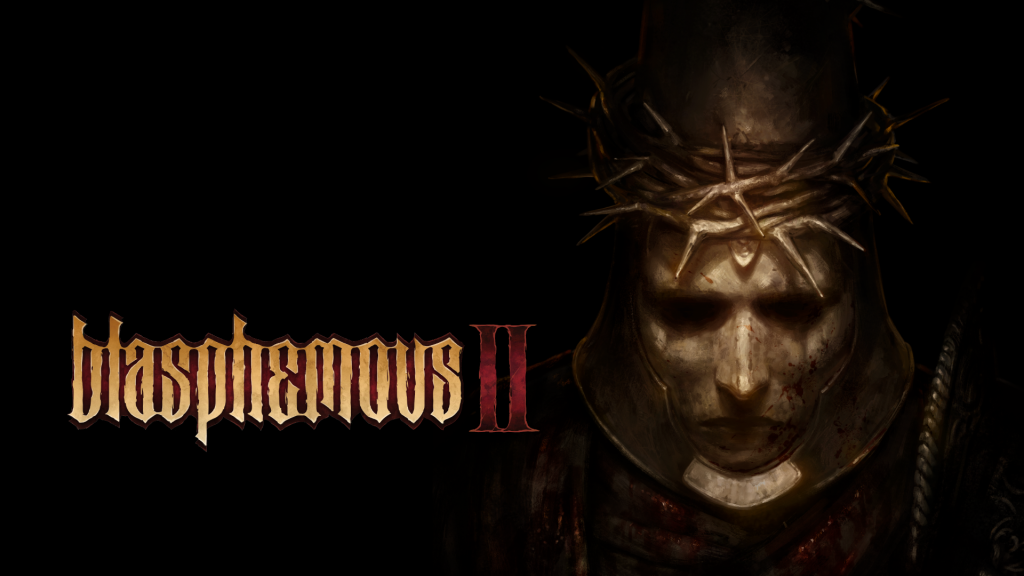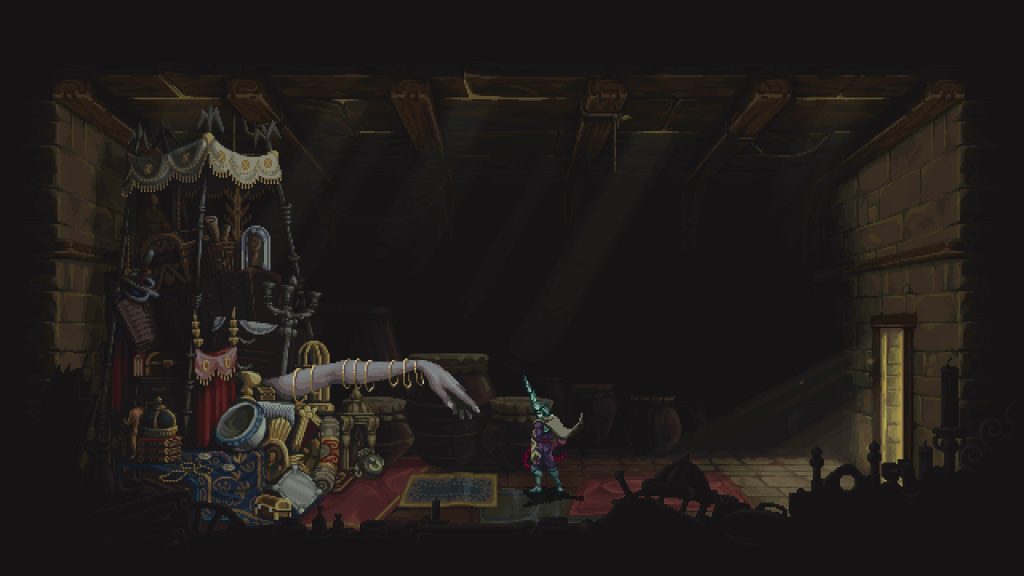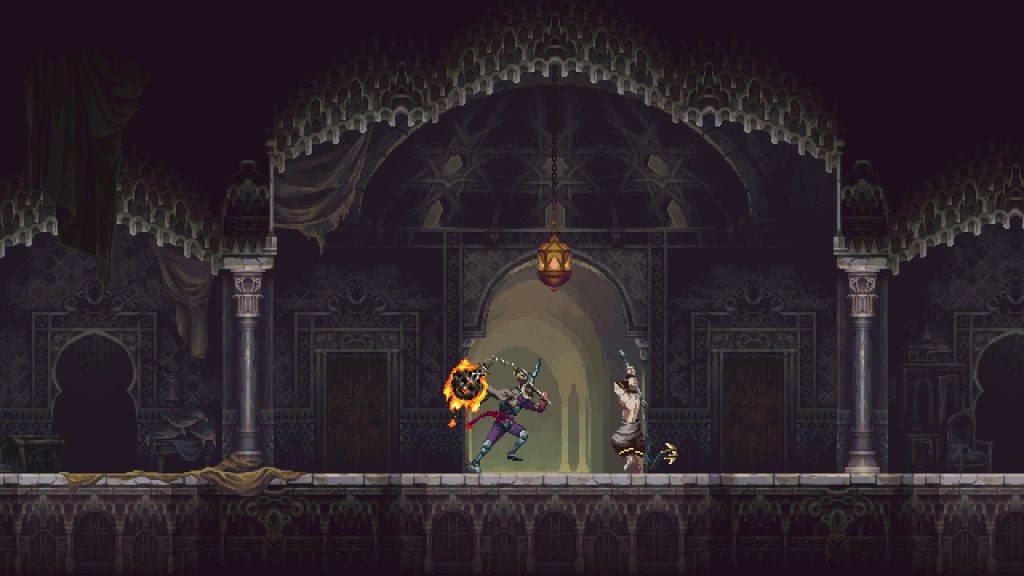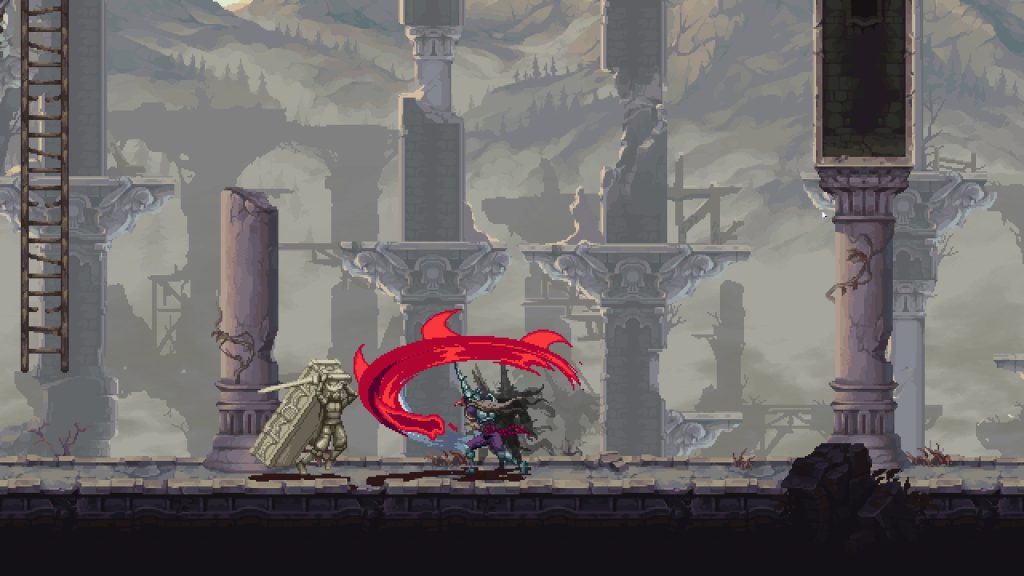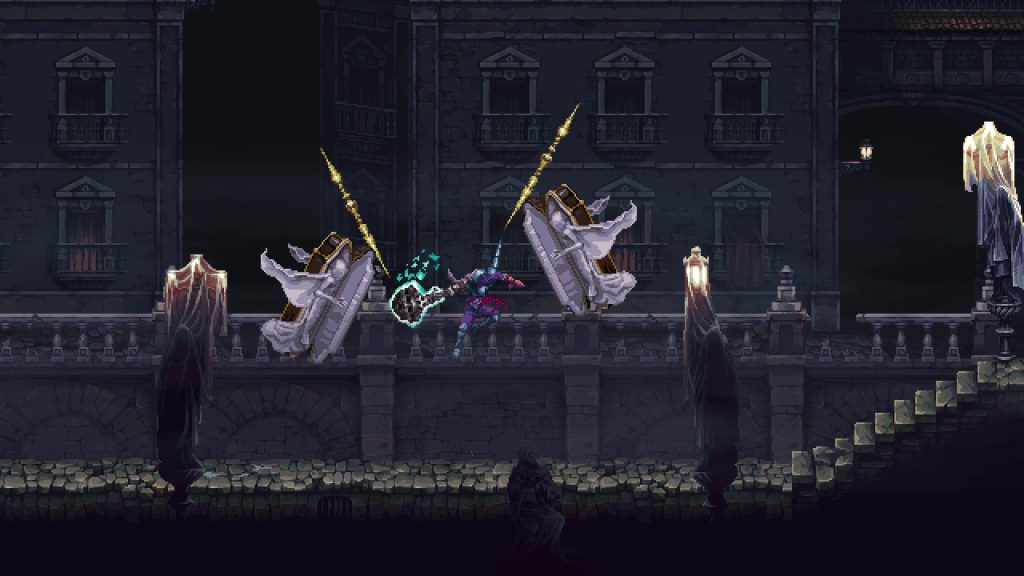The original Blasphemous came out in 2019, fast becoming an indie darling with its challenging combat, evocative music, and just a truly distinct vibe. My Steam playtime came in at nearly 50 hours thanks to multiple playthroughs, achievement hunting, and all the post-release DLC and other free updates. Needless to say, I’ve been very much looking forward to Blasphemous II.
The story picks up right where the final DLC, Wounds of Eventide, left off. The Penitent One awakens in a strange new land where a gargantuan beating heart has descended from on high, heralding the birth of a new Miracle. You’re left with no choice but to explore this eerie place, fighting grotesque abominations, collecting powerful prayers, and meeting the sorry folk who call this land home.
This series’ biggest strength is its art style and overall aesthetic. Spanish developer The Game Kitchen has combined the imagery, language, and symbolism of catholicism (more specifically the Spanish Inquisition) and Medieval Gothic art and architecture, to create a mythos that is all its own. Every environment, enemy, and boss is simply a joy to behold, thanks to their absurdly imaginative, otherworldly design.
Blasphemous II plays a lot like many other 2D sidescrolling action games. You attack in combos, dodge enemies, and jump your way across bottomless pits. As with the original, it does borrow some elements from Souls games. You are burdened with guilt upon death, which takes away a chunk of your fervour (mana). You must either return to where you died without dying again or go to confession and offer tribute to absolve yourself of guilt. There is otherwise no punishment for dying beyond having to start back at the closest checkpoint, which there are plenty of.
The exploration in Blasphemous II is sublime. You never quite know what the heck you’re going to come across next. It could be a tricky boss with a jaw-dropping design, an entire subsection you didn’t know existed, or an enormous man sticking out of the ground with thick, sappy honey gushing out of his mouth. That one particular doorway you chose to ignore early on could actually lead to an entirely new area dripping in atmosphere with new enemies and abilities to find. Blasphemous 2 is wonderful at keeping you guessing right up until the credits.
Each area, whether it’s the Palace of the Embroideries, Profundo Lamento, or the Aqueduct of the Costales, has its own music and enemy types, with some even featuring unique gimmicks. For example, one area sees you exploring a ruined temple partially buried in sand. Hidden away are these big glass vessels which, by smashing them, allow you to alter the level of sand somewhere nearby. The majority of zones may feel distinct, but there are a handful that forgettable ones. Not overly boring or tedious to get through, just not as remarkable as the others.
The sequel shakes things up right at the start of the game by making you pick from one of three weapons. There is Veredicto, a slow but strong censer that you can wield as a flaming flail. Sarmiento and Centella is a fast but weak rapier/dagger combo that builds up lightning damage the more attacks you get in without taking damage. Finally, there is Ruego Al Alba, a more standard sword that is essentially what you had in the first game, with a few new twists of course.
Like picking a starter Pokemon, whatever two weapons you don’t pick won’t be available again until you find them out in the world. This choice won’t just impact how you approach combat, but also the order in which you explore the world, as each weapon has its own traversal mechanics too. The dagger combo lets you blink using floating mirrors, the flail is used to ring bells that cause platforms to briefly appear, and the sword has a downward strike that clears certain barriers.
Combat is a blast. Swapping through all three weapons depending on the situation is a lot of fun and each feels viable in its own way. As you explore and kill enemies you will gather Matyrdom Points, which can be used to unlock skills for each of the three weapons. These range from straight stat boosts to entirely new skills like a shockwave that emanates from Veredicto after a charged attack.
These unique weapon abilities are in addition to the standard Metroidvania upgrades like a double jump and mid-air dash that can be found through exploration. Additionally, there are various items and abilities that allow you to buff resistances and cast powerful prayers. All of these systems come together to provide a deeply satisfying feeling of progression. Finding new abilities is not only fun in and of itself, it also makes you look at the whole map with fresh eyes. I think unlocking double jump in games like this will remain exciting until the day I die.
It seems to me that Blasphemous II is somewhat easier than the first game, although this may be because of how much I played it. The sequel definitely gets harder as you go along, with one area in particular feeling like a very deliberate difficulty spike; a clear indicator that it was time to go back and explore earlier environments to increase my health and damage output. The bosses often made a daunting first impression, but I was able to get them all after only a handful of attempts, with the majority going down in one try. The only real challenge was the penultimate boss, who forced me to utilise everything I had collected and learned so far. Overall, I would say the difficulty is pretty well balanced although I wouldn’t be surprised if the first post-launch patch includes quite a lot of combat tweaks.
The music is another standout. Heavy use of Spanish guitar creates an appropriately medieval tone while also not really sounding like any other game out there. It’s beautiful stuff, ranging from solemn and ghostly funeral marches to ethereal yet somehow triumphant faster tracks. This is rounded out by the music that plays during boss fights, which often goes for a more modern sound with electric guitars and drums.
The English voice acting is much improved this time around. There are a number of occasions where the actors have to deliver extremely long sentences (not sure if they’re equally long in Spanish or not) and while it can sometimes sound a little awkward, they do a great job of plowing through. An ever-important element of Metroidvanias is the sound design, and I can safely say that every swing of a weapon, and every crunch of it connecting with a foe, is deeply satisfying. Audio feedback with fast-paced, pixel-perfect combat and platforming is integral, and Blasphemous II doesn’t disappoint.
The cutscenes have had an increase in budget, appearing less like something from an early PC game and more like a psychedelic animation you found on some weird VHS in your parent’s house. They’re short and sweet, but do a wonderful job adding depth to the world.
In general, Blasphemous II feels snappier and more polished than its predecessor, issues like the Penitent One having difficulty grabbing ladders are thankfully a thing of the past. Another welcome edition is that pits of spikes no longer kill you in one hit. Instead, you lose a decent chunk of health but are otherwise transported to the closest piece of solid ground.
That said, I did encounter a couple of annoyances. More than once I got stuck between two enemies, taking a huge amount of damage before I even realised what happened. This became less of an issue as I gained more health and healing vials, but was frustrating early on. Another issue is the bizarre inability to skip through dialogue in certain boss fights. The most challenging fight in the game has your adversary say multiple lines as you start the fight, and even more when you transition to his second phase. Given how many times I was dying against this guy, not being able to skip immediately to the second phase after beating the relatively easy first phase was super painful.
Blasphemous II is a fantastic sequel. It carries on doing what the original did so well while successfully adding to and improving the formula. It offers fun platforming, interesting traversal abilities, challenging combat, and a morbidly fascinating art design. Every element of this game, whether it’s the haunting soundtrack, crunchy sound design, or gripping voice acting, comes together to create an experience unlike any other. The Game Kitchen solidified its voice with the original, but with Blasphemous II that voice has grown into a choir. A new Miracle is upon us.
Rating: 9/10
Blasphemous II was reviewed on PC with a code provided by the publisher.

